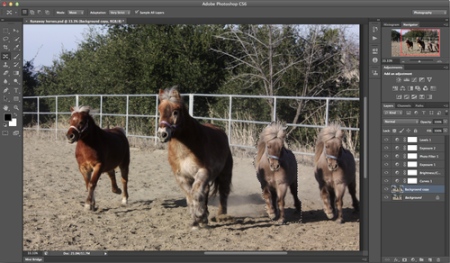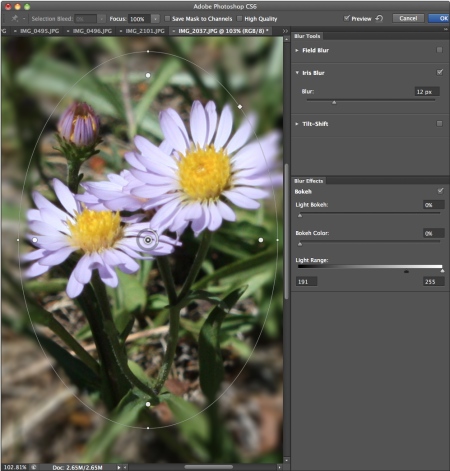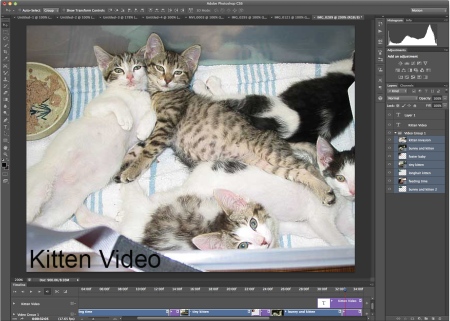Adobe has announced, for the second time in its history, a free public beta of Photoshop. Photoshop CS6 will be available to try for the next few months as Adobe readies its Creative Suite of applications for launch alongside the brand new Creative Cloud online hub, targeted to creative pros. The Photoshop beta is available now on Adobe Labs. The new Photoshop version works only on 64-bit Mac systems, and no longer in 32-bit mode.
Various under-the-hood improvements promise to make life easier and protect long hours of labour intensive operations. The highest profile of these include Background Save and Auto Recovery, Preset Migration and Sharing, and the new Mercury Graphics Engine.
Simply selecting some program preferences lets Photoshop automatically save and recover your work in the event of a power interruption. When you upgraded from previous versions of Photoshop, you often lost painstakingly applied presets that automated many repetitive tasks. The new version lets you apply your presets, tools, and workspaces to the new upgrade. While the Mercury engine is familiar to users of Premiere Pro, Photoshop’s new Mercury Graphics Engine is mostly a software-based implementation of multicore functionality.
The dark side
The changes in the new version of Photoshop are immediately apparent. The program has gone over to the dark side by default, opening to a sophisticated-looking dark gray interface. This is intended to complement themes of some of Adobe’s other creative programs-specifically Lightroom 4, Premiere Pro, and After Effects.
Additional default themes in medium gray, light gray, and black are also included. However, you can set the interface colors to whatever you want, and they change immediately. The same holds true for Photoshop’s companion asset management application, the now 64-bit Bridge. The dark, Aperture-like theme looks attractive, but as with all light type on a dark background, menu items can be difficult to read.
And speaking of interface updates, Adobe has also redesigned and streamlined the program’s menu icons, though they’re still familiar and easily recognizeable. Panels are now labeled in upper- and lowercase type instead of in all caps, enhancing legibility. A new Properties panel now combines Adjustment layer and Mask settings into a single panel. Attention to such details keeps the Photoshop looking fresh.
Content awareness
In past versions of Photoshop, Adobe introduced the concept of content-aware image technology, in which edits can take into account the relationship between objects and elements in an image. This lets you edit in an intuitive way with more realistic looking results. Adobe now has added to the content-aware features of previous versions the new Content Aware Move and Content Aware Patch functions. The Content Aware Move tool lets you pick up an object and relocate it to another part of the image while the program performs a content-aware fill operation in the background. The Patch tool’s new Content Aware option, a more refined cloning operation, lets you choose the pixels used to fill a designated area in an image, as opposed to letting the program decide. Thus, Photoshop performs a little extra blending to make lines and patterns match.

Content awareness
Layer improvements
Over the years, Photoshop’s layers feature has received much attention and many improvements. Photoshop CS6 adds a Layer Search function and the use of vector layers to apply-for the first time-strokes, dashed lines, and gradients to vector objects. Other tweaks include the ability to simultaneously change the blend mode of and to duplicate multiple layers. You can also now see opacity, fill, and blend modes of hidden layers. And you can now simultaneously change layer styles and effects for all layers in a group.
Adaptive Wide Angle filter
Photoshop CS6 offers a new way to achieve lens corrections. The Adaptive Wide Angle adjustment filter lets you quickly straighten objects that appear curved in photos shot with wide-angle or fish-eye lenses, or panoramas created with Photomerge. Using Adobe’s CS5 lens correction system, which fixes lens-based geometric distortion, chromatic aberration, and vignetting, the new filter reads lens metadata and lets you click and drag new on-canvas tools to straighten and align objects vertically or horizontally in the scene.
Crop tool
Photoshop CS6’s GPU-enabled, nondestructive Crop tool sports new composition controls. Whereas CS5 included a basic grid and Rule of Thirds overlay, CS6 lets you preview Golden Ratio, Diagonal, Triangle, and Golden Spiral overlays. You can also use the new Perspective Crop tool to straighten images. The new Crop tool is designed to help you change the aspect ratio (shape) of your image more easily, without accidentally changing resolution and thus the image quality.
Blur Gallery
Added to Photoshop CS5’s 11 Blur plug-ins is a new Blur Gallery consisting of Field Blur, Iris Blur, and Tilt-Shift. These on-image controls add blurs to any image without requiring selections, layers, or depth maps. Iris Blur creates a shallow depth of field and lets you control the blur’s area and intensity. Field Blur lets you pinpoint (with a virtual pushpin) the parts of an image you want blurred and control blur intensity. The Tilt-Shift blur applies blurs along one or more planes, letting you adjust both location and intensity, like the popular Lensbaby tilt-shift lens. You can also apply and adjust a bokeh (background blur) effect with any of the three new Blur tools. The Blur Gallery offers a full-screen preview with collapsible panels, allowing you to see your results at a respectable size.

Blur Gallery
Camera Raw 7
You can edit an image in the Camera Raw interface whether or not it was shot in Raw format. Adobe has rewritten the Camera Raw Basic panel and its controls for easier use. All sliders start at zero, so it’s easy to see how to fix even low-resolution shots. Two new controls, Highlights and Shadows (derived from Lightroom 4’s processing engine) help pull more detail from images than previous Raw plug-ins. Overall, the Camera Raw 7 plug-in offers more image controls that can be applied with the Adjustment Brush, including Temperature, Tint, Highlights, Shadows, Noise Reduction, and Moiré Reduction.
Painting and Drawing
Photoshop would not be Photoshop without fresh tools and streamlined methods of painting and drawing. New erodible brush tips are designed to wear down naturally. You can also use erodible tips with the Brush tool, Pencil tool, Mixer Brush tool, and Eraser tool. A new Airbrush tip features a real physics engine to make airbrushing more realistic. That’s in addition to improved brush rotation, painting presets, and more. A new Oil Paint filter lets you instantly turn a photo into an oil painting.
Video
Photoshop CS6’s new video functionality-designed as a starting point for video creation-features a new Timeline panel in addition to Photoshop’s familiar Animation panel. The workflow, targeted to photographers, includes letting you create, edit, splice, and add audio track and transitions to your clips in a drag-and-drop interface. Having all Photoshop’s editing tools at your disposal offers manifold artistic options. You can then export and render video in a number of formats.

Select and drop video clips and stills into the timeline
Improved Auto Correction
Photoshop always let you automatically correct images with various controls under the Image menu. Photoshop CS6 approaches auto corrections in a different and more intelligent way. Auto options are available in Curves, Levels, and-for the first time-Brightness/Contrast controls. The interface is the same, but the underlying algorithms driving them have changed. The Auto button derives its results from a database of thousands of hand-edited images. An Enhance Brightness and Contrast algorithm-developed with reference to thousands of manually corrected examples-bases calculations on image data.
3D
Adobe has revamped its 3D engine for CS6 to make it easier and faster to create and manipulate 3D objects. A new in-context and on-canvas editing interface is designed to enhance usability. Right-clicking on a 3D object shows contextual pop-up panels with content of the panel related to the area clicked.
Adobe has scrapped CS5’s large Reposé dialog box and subsumed the 3D technology into the interface. Now, a Properties panel and widgets enable 3D extrusion and the manipulation of 3D objects in real time. The program also supports draggable shadows and ground plane reflections. The Picture In Picture window shows an alternate view of the 3D object. With it, you can switch camera views, pan, zoom, and swap this view with the main document window.
For combining 2D and 3D functions, you can add 3D objects to a photo and have the object align with the Vanishing Point of the image.
Skin tone aware selections and masking
Photoshop CS6 introduces more controls for preserving skin tones in images where you either want to change or adjust the skin color, or preserve skin tones as you change other parts of the picture. The Color Range dialog box, under the Select menu, offers both a Skin Tones option and a Detect Faces checkbox. Used in concert, they can help you create an accurate mask.
There’s lots more
These are only a few highlights of the new Photoshop CS6 upgrade, now available in beta on Adobe Labs, and due out by summer. There’s a lot more to look at in the beta, including Character and Paragraph styles, and a lorem ipsum generator for creating placeholder text and Rich cursors, a handy informational overlay that appears whenever you use the Move, Crop, Free Transform, and similar tools. It shows size information, rotation angle, and x/y coordinates. The new version of Photoshop welcomes Contact Sheet II and PDF Presentation back into the package, as well as a redesigned, streamlined print dialog box. New Bicubic Automatic image resampling (handy for enlargements) lets Photoshop pick the best interpolation method. It’s also used with the Crop tool and Free Transform tools.